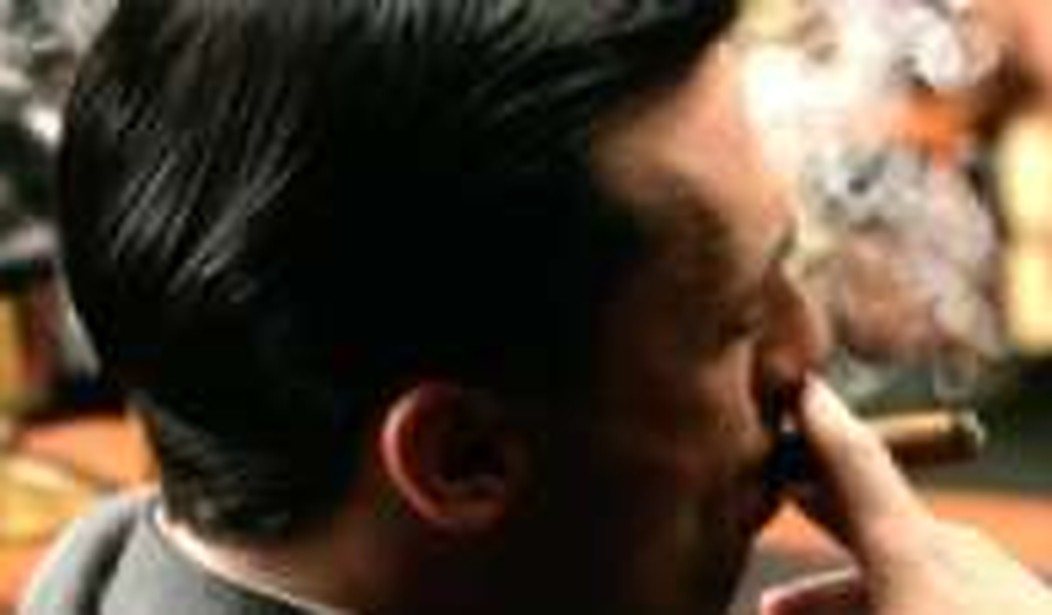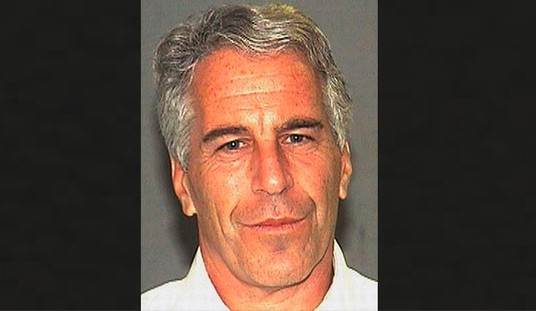Watching the kick off of AMC’s new 13-part miniseries Mad Men, I almost felt like reaching for an asthma inhaler as I peered through the perpetual blue cigarette haze of the opening scene’s swank Manhattan bar.
The show’s protagonist, advertising’s equivalent to Wall Street’s Gordon Gekko, is the equally-Brylcreemed Don Draper, portrayed by Jon Hamm. We find Draper alone in a booth inside a swank Manhattan bar. Draper, the opening scene, the extras contained within it all look right-all the men have dark suits, skinny lapels, tie clips, and similarly Brylcreemed hair; all the women have beehives, high heels, and skirts.
Draper is the creative director for the fictitious Madison Avenue Sterling Cooper ad agency. He’s wrestling with his assignment for the next day: coining a slogan for one of his firm’s biggest clients, Lucky Strikes, in an era when the Surgeon General is first turning up the heat against the tobacco industry.
Deconstructing Ike’s America
When I interviewed James Lileks in the fall of 2005 for a profile that ran during Pajamas’ earliest days, he told me, “trying to reconstruct any past from its advertising culture is like trying to reconstruct a snowflake from a drop of water-it’s very hard to get an accurate and true picture.”
And that’s exactly what the AMC cable channel’s new series Mad Men is attempting to do. When Lileks says “reconstruct any past from its advertising culture”, he’s referring to viewing scraps of American culture as reflected by advertisements-an exercise in which Lileks excels. But Mad Men attempts to deconstruct the America of the late 1950s literally through its advertising culture: men like Draper who ran Madison Avenue.
Mad Men‘s first episode takes place in March of 1960; and while the calendar may have a six in it, the real sixties didn’t fully get here until after JFK’s demise. Making Mad Men very much a look back at Eisenhower’s Gray Flannel 1950s.
Or at least the way Hollywood remembers Ike’s America. Since the 1970s, television has always had an uneasy relationship with that era: Happy Days and Laverne & Shirley reveled in it, Archie Bunker wanted to go back to it, M*A*S*H used it to attack the Vietnam War, and now Mad Men uses it to attack the advertising industry.
In the hands of a writer like Larry Gelbart or the late Terry Southern, this could be wonderfully satiric stuff, as Gelbart’s own hilarious send-up of the intersection of Tobacco and Commerce in HBO’s Barbarians At The Gate demonstrated. But the writers and producers of Mad Men don’t seem interested in the same level of broad performances and Swiftian satire that Gelbart’s earlier made-for-cable effort aimed at.
Nonetheless, some occasionally humorous moments intercede, particularly for historians of pop culture. Early in the episode, as Draper is wrestling with his copywriter’s block, a parody of a female ’50s German Freudian psychiatrist visits his office with her research into cigarette smoking and mass culture. “Before ze War”, she says, in a tone and dialogue that vaguely recalls Peter Sellers’ demonic Dr. Strangelove or his earlier Dr. Zempf character from Lolita, “when I studied with Adler in Vienna, we postulated that what Freud called the death wish is as powerful a drive as those for sexual reproduction and physical sustenance”.
While played by an actress younger than Lotte Lenya in 1963, she looks and sounds exactly like Lenya’s Teutonic Rosa Klebb character in the second 007 film, From Russia With Love. It sounded like her character’s name was “Dr. Godwin“, which would have suited the writers’ intentions, perfectly.
That’s a rare moment of satire in Mad Men that works. As for the rest of the show, what’s a bit surprising is how formulaic it all seems, especially when compared to the level of hosannas being shouted from critics. But really: an episode about an ad agency and smoking? Who didn’t see that one coming? I wonder who decided that this would be the first episode, the producers or the network. It starts the series off rather clumsily, as if the M*A*S*H series began with the slapstick of Colonel Flagg, the show’s occasional bumbling CIA agent parody. Or if Star Trek debuted with a cartoon salt vampire running amok through the USS Enterprise.
When New Puritans Look Back
Oh, wait, Star Trek did debut on NBC with that one; some things never change on TV, it seems. But then, some things never change amongst American culture and its discontents, either. We couldn’t have been too naive about advertising back then, what with The Man In The Gray Flannel Suit a hit 1956 movie starring Gregory Peck as the eponymous lead. Or the following year’s The Sweet Smell Of Success, with Tony Curtis and Burt Lancaster in the black-as-pitch cynical world of Manhattan PR.
In a way, while attempting to attack the Puritanism of the late 1950s, Mad Men simultaneously demonstrates contemporary liberalism’s own 21st century streak of Puritanism. What’s remarkable in its subtle (and sometimes not-so-suble) but endless attacks on the era and its excesses: smoking, drinking, sexism, etc., is how puritanical itself the show appears. It takes a lot of hubris for Hollywood to lecture about sexism and unfair labor practices. Or to complain about a nation that’s overly exuberant with its intoxicants and vices.
And it’s hardly a new concept. In his 2000 essay, “In The Land Of The Rococo Marxists“, Tom Wolfe wrote that literary fiction’s goal beginning in the 1920s and 30s “was to pull back the covers from this apple-cheeked, mom’s-cooking country of ours and say, ‘There! Take a good look at what’s underneath! Get a whiff of the rot just below the surface!’-the way Sinclair Lewis did it in Main Street and Babbitt, for which he became the first American to win the Nobel Prize in literature.”
As Wolfe added, Lewis’s contemporary Sherwood Anderson created a stock character similar to Lewis’ Elmer Gantry “that others have been laboriously cranking out ever since in books, TV, and movies, from Peyton Place to American Beauty.”
There’s much of that in Mad Men, which has the same hypocritical stock characters dating back to the era of Babbitt, Elmer Gantry, and later, Sweet Smell of Success‘s J.J. Hunsecker and Wall Street‘s Gordon Gekko. Near the end of Mad Men‘s first episode, Draper even delivers a line to a rare female client that “What you call love was invented by guys like me to sell nylons.” It echoes a strikingly similar line spoken by Gekko in Wall Street.
And next week? Draper wrestles with an even bigger existential crisis than the selling the tobacco industry: selling Nixon.
Yet another plot that reinforces in its own way something that Mad Men‘s debut illustrates: it’s not easy dreaming up concepts to pitch at the spur of the moment. But then, as Woody Allen once quipped, 80 percent of success is just showing up.
Draper couldn’t have said it better.
Ed Driscoll has been writing professionally since 1995, often on topics that intersect technology, politics, and pop culture, for magazines ranging from PC World to Guitar World. A denizen of the Blogosphere since early 2002, his Website can be found at http://eddriscoll.com/weblog.php.









Join the conversation as a VIP Member